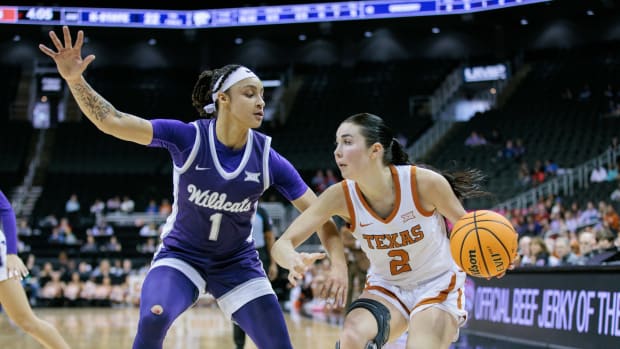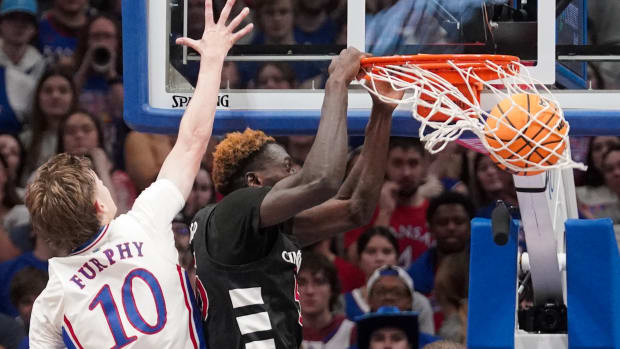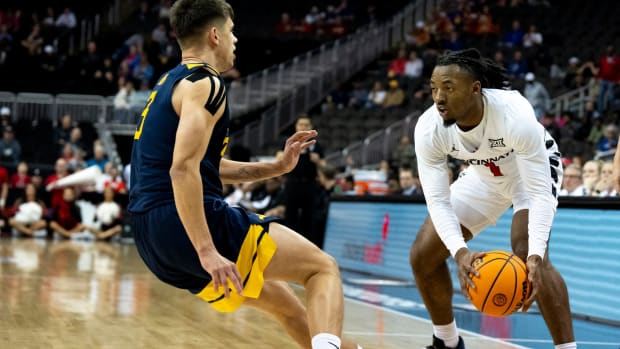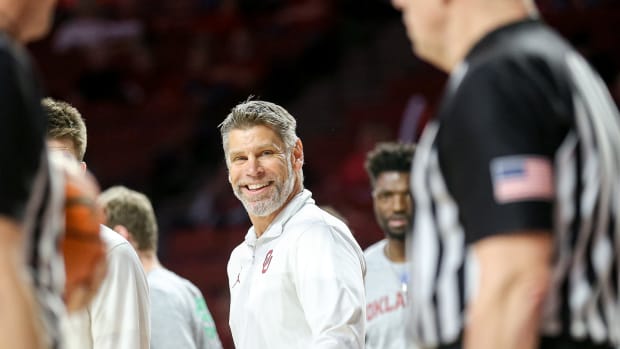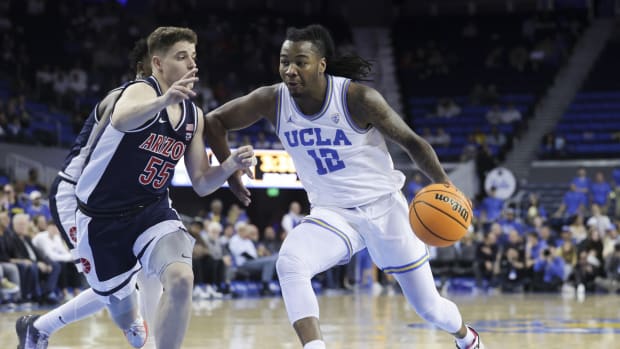Power Rankings: Kansas rises to the top spot
The first Power Rankings of March see a new No. 1 (Kansas), UCLA rejoining the top five, and a surging Big 12 team making its debut at No. 16:
1. Kansas Jayhawks
PREVIOUS: 2
RECORD: 27-3
The Jayhawks seem built for maximum drama this season, and I can't imagine them making a national title run that wouldn't include at least a couple of games that went down to the final possession. With March upon us, it seems worthwhile to review KU's approaches for getting a full-court game-winner or game-tying bucket.The "chop" play that Kansas used to send the 2008 national title game to overtime has been so widely copied that they seem unlikely to run it exactly this way again:When the Jayhawks needed to tie their season-opener against Indiana, they ran a modified chop with the inbounder (Landen Lucas) running ahead of the play to set a downscreen for Frank Mason, who rose up from the wing, and took a handoff near the top of the key:At the end of overtime in their home loss to Iowa State, the Jayhawks ran the left-wing chop handoff (from Mason to Devonte' Graham), but added in another handoff (to the trail man, Svi Mykhailiuk) for misdirection:And at the conclusion of the first half in their win at Baylor, the Jayhawks ran a play with no chop—instead, it was a modified version of the end of Villanova's "Nova," with the ballhander (Mason) pitching back to a trail man (Josh Jackson) and freeing him for a three with a brush screen:Next up: 3/4 at Oklahoma State
2. Gonzaga Bulldogs
PREVIOUS: 1
RECORD: 29-1
Prior to the Zags' loss to BYU that derailed their perfect season, it didn't seem like a big deal that they were missing Killian Tillie, a freshman sub who broke the fourth finger on his shooting hand in mid-February. The French power forward had been averaging just 13.4 minutes per game, but they were often productive minutes. Gonzaga's most efficient frontcourt duo, according to data from hooplens.com, is Tillie at the 4 and fellow freshman Zach Collins at the 5. In their 364 Tillie-Collins possessions this season, the Zags have a massive, positive efficiency margin of +0.42 PPP—and their second-most efficient frontcourt duo is Tillie with senior Przemek Karnowski: Next up: WCC tournament in Las Vegas
3. Villanova Wildcats
PREVIOUS: 3
RECORD: 27-3
Last January, Jay Wright told me that he expected his teams' three-point rate (its ratio of threes to overall field goals) to be higher early in the season, when he gives players freedom to find their shot, then gradually decline closer to 40%. In November and December he's generally breaking new players into his rotation, "and we have to teach them to look for the three," Wright said. "You start by being aggressive, then you acquire the decision-making and shot-selection skills that we want from being aggressive, not from being tentative." In 2015–16, the Wildcats' three-point rate remained over 50% in December before ending the season at 42.7%. They didn't have the same, early-season spike in 2016–17, but by the time Big East play rolled around, the three-point rate started following the same path as last season:Next up: 3/4 at Georgetown
4. UCLA Bruins
PREVIOUS: 8
RECORD: 27-3
Lonzo Ball had eight more assists in the Bruins' rout of Washington on Wednesday, bringing his season total to 227. He's producing 18.3 assist points per game in addition to the 15.0 he's scoring, which means he's accounting for an average of 36.1% of UCLA's points. I'm curious to see if his production will drop at all if he's missing fellow freshman T.J. Leaf, who suffered a bad ankle sprain in the win over the Huskies. There's no word yet regarding Leaf's return, but he's been Ball's favorite target this season, receiving 56 dimes (including 19 for dunks) from the likely All-America point guard. Here's the latest update of the Power Rankings' Lonzo Distribution Chart:Next up: 3/4 vs. Washington State
5. North Carolina Tar Heels
PREVIOUS: 5
RECORD: 25-6
If the Tar Heels are going to avoid another loss to Duke on Saturday, they'd be wise to find ways for anyone but Matt Jones to be guarding their best scorer, Justin Jackson. When Jones, the Blue Devils' starting three-man and perimeter stopper, was marking Jackson in the teams' first meeting of 2017, at Cameron Indoor Stadium on Feb. 9, the results weren't pretty. Jackson shot 0-for-4 when Jones was his primary defender, 1-of-2 when Jones was his help defender, and drew one foul on Jones, producing a total of three points.When Jackson was being checked by any other Duke player, or open in transition, he scored 18 points. Here's a film edit of Jones' handiwork:Next up: 3/4 vs. Duke
6. Oregon Ducks
PREVIOUS: 4
RECORD: 26-4
Ducks senior Jordan Bell needs more recognition nationally for the incredible defensive season he's having, as the anchor of a potential No. 1 or 2 seed in the NCAA tournament. Just three players from multi-bid conferences—and eight overall in D-I—have a defensive rebound rate better than 20%, a block rate better than 5% and a steal rate better than 2%, and Bell is one of them:Data source: barttorvik.comNext up: 3/4 at Oregon State
7. Baylor Bears
PREVIOUS: 6
RECORD: 24-6
Last Friday, I had to submit my list of 10 semifinalists for the Naismith Trophy's coach and player of the year. In the interest of transparency, these were my top 10 COY candidates; they were not submitted in any order, but this is how I'd order them:1. Mark Few, Gonzaga 2. Scott Drew, Baylor 3. Jay Wright, Villanova 4. Chris Collins, Northwestern 5. Sean Miller, Arizona 6. Chris Holtmann, Butler 7. Mike White, Florida 8. Steve Alford, UCLA 9. Bob Huggins, West Virginia 10. Leonard Hamilton, Florida State/p> My criteria was a combination of "performance compared to expectations," and "overcoming adversity," so that's why Bill Self, Roy Williams and John Calipari aren't on the list: their teams are pretty much who we thought they'd be. Few is No. 1 because he lost four starters from last year's Zags, including two to the NBA, and then started 29–0. Drew went from outside the preseason polls to a likely No. 2 seed in the NCAAs, which in most years would be a feat worthy of the top spot. Next up: 3/4 at Texas
8. Louisville Cardinals
PREVIOUS: 9
RECORD: 23-7
Staying on the transparency kick, these were the 10 players I submitted on my Naismith Trophy POY semifinalists ballot. They did not need to be submitted in any order, but this is how I'd order them:1. Frank Mason III, Kansas 2. Josh Hart, Villanova 3. Caleb Swanigan, Purdue 4. Lonzo Ball, UCLA 5. Johnathan Motley, Baylor 6. Ethan Happ, Wisconsin 7. Nigel Williams-Goss, Gonzaga 8. Justin Jackson, UNC 9. Donovan Mitchell, Louisville 10. Dillon Brooks, OregonMitchell and Brooks did not appear on the Naismith Trophy's semifinal list; in their place were Duke's Luke Kennard and Kansas' Josh Jackson, both worthy candidates. I passed on Kennard in favor of Mitchell because of the defensive aspect; Mitchell is the efficient go-to guy on a top-10 team and the perimeter lockdown guy for an elite defense, whereas Kennard's contribution is mostly on offense. Brooks' minutes have been limited due to his recovery from a foot injury, but he's been the nation's preeminent big-shot maker—even bigger than Mason!—and contributes plenty on D. Next up: 3/4 vs. Notre Dame
9. Kentucky Wildcats
PREVIOUS: 14
RECORD: 25-5
Tuesday's win over Vanderbilt was yet another instance where a monster, Malik Monk scoring night (27 points on 21 shots!) saved the Wildcats. While "Kentucky is better when Monk scores big" seems like an obvious statement, I wanted make sure it was actually true, so I ran adjusted splits on the Wildcats' season in two ways …* When Monk scores more than 20 points, versus all other games* When Monk scores more than 25 points, versus all other games… to gauge the impact. And yes: Kentucky's offense has been significantly better when Monk is rolling, although its defense has been slightly worse: Next up: 3/4 at Texas A&M
10. Arizona Wildcats
PREVIOUS: 7
RECORD: 26-4
The only way I can see Arizona as a title contender is if it can revert to guarding like it was in late December and early January, when it had one of the nation's best overall defenses. Since then, the Wildcats have been trending into dangerous territory; their adjusted defensive efficiency rating over their past three games is 100.1, which is equivalent to a D ranked in the 70s. Take a look at Arizona's season-long, adjusted-efficiency trends (the running three-game averages, and you'll see that its offense has been top-10 caliber of late, but its D is leaving it less room for error:Next up: 3/4 at Arizona State
11. Duke Blue Devils
PREVIOUS: 11
RECORD: 23-7
After Frank Jackson came up huge for the Blue Devils in their Tuesday win over Florida State, scoring 22 points in his first start since Feb. 4, I ran his on/off efficiency splits—and was amazed at the result. The eye test suggests that Jackson is somewhat of an over-dribbler and under-assister while playing point guard, but Duke has played significantly better with him in the lineup in ACC games, and especially during the month of February. Over the eight games this month, according to hooplens data, the Blue Devils have an efficiency margin of plus-19 points per 100 possessions with Jackson, and negative-6 without him: Next up: 3/4 at North Carolina
12. Butler Bulldogs
PREVIOUS: 15
RECORD: 23-6
Junior forward Kelan Martin, the Bulldogs' highest-usage and lowest-efficiency starter for most of the season, was removed from their starting lineup at the beginning of February. He did not take to it well at first, scoring just one point in a Feb. 7 win at Marquette (in which he was benched for the entire first half), and then eight (on 3-of-11 shooting) in a loss at Providence on Feb. 11. But in Butler's four most recent games, Martin has fully acclimated, morphing into the super-high-efficiency scorer its offense needs. Martin has an incredible offensive rating of 132.5 on 28.1% usage during that 4–0 stretch, and he told the Indianapolis Star, "I think just coming off the bench is best for me and our team." That is definitely the case, as his numbers over his first 13 Big East games were abysmal: Next up: 3/4 vs. Seton Hall
13. West Virginia Mountaineers
PREVIOUS: 10
RECORD: 23-7
Even though the Mountaineers have seven losses and are tied for third place in the Big 12, their adjusted efficiency ratings are so strong that they rank No. 4 overall in kenpom.com's rankings, and are close enough to No. 3 North Carolina that they could surpass the Tar Heels with a few good results in the Big 12 tournament. That means bracketing scenarios exist where West Virginia, currently projected as a 4-seed, could get slotted into a region where it's a more efficient team than the 1, 2 and 3 seeds—say, if it ends up in the South with Carolina, Kentucky and Arizona. Next up: 3/3 vs. Iowa State
14. Purdue Boilermakers
PREVIOUS: 12
RECORD: 24-6
The Boilermakers' three-point rate (their ratio of three-point attempts to overall field goal attempts) has been climbing each of the past five seasons, and is not at 38.4%—the highest of the Matt Painter era. And if there were ever a year to break new ground in that metric, it's this one, as Purdue ranks fourth nationally (and first in the Big Ten) in three-point accuracy at 41.4%. Playing five-shooter lineups with Biggie Swanigan at center is producing positive, long-range returns.Next up: 3/5 at Northwestern
15. Florida Gators
PREVIOUS: 13
RECORD: 24-6
Yet another sign that the Gators' defense is surviving without injured junior center John Egbunu, who was lost for the season on Feb. 14: On Wednesday, they held Arkansas to 0.96 points per possession, the lowest the Razorbacks' offense has scored all season. And Florida did it by protecting the interior, too, allowing Arkansas to shoot just 34.9% inside the arc. It's wild that Mike White, in just his second season, has the Gators ranked higher in adjusted defensive efficiency (No. 4) than either of Billy Donovan's national-title teams, which were 7th and 15th. Next up: 3/4 at Vanderbilt
16. Iowa State Cyclones
PREVIOUS: 23
RECORD: 20-9
At the end of January, the Cyclones were 13–8 overall and 5–4 in the Big 12, and in jeopardy of missing the NCAA tournament. Since then they've gone 7–1, become the only team to beat Kansas at Allen Fieldhouse this season, defeated likely tourney teams Baylor and Oklahoma State, and made themselves a lock to appear in the bracket. The odd thing is, their kenpom ranking has barely changed at all during that time—going from 28th on Feb. 4 to 23rd today. They were an efficient team in January without most of the country really noticing it; what's changed since is their luck, winning percentage, seeding situation and national perception.Next up: 3/3 at West Virginia
The Next 16
17. Notre Dame
18. SMU
19. Virginia
20. Florida State
21. Cincinnati
22. Oklahoma State
23. St. Mary's
24. Miami
25. Minnesota
26. Wisconsin
27. Wichita State
28. Dayton
29. Michigan
30. Illinois
31. Middle Tennessee
32. UNC Wilmington
















